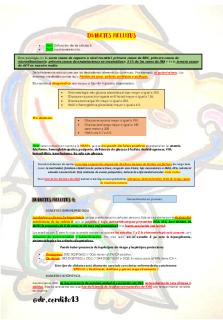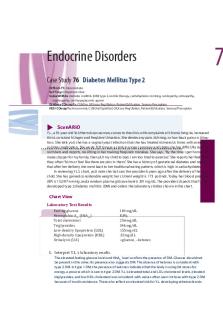Case Study 81 Diabetes Mellitus Type 1-1 PDF

| Title | Case Study 81 Diabetes Mellitus Type 1-1 |
|---|---|
| Course | Health-Illness Concepts Across the Lifespan I |
| Institution | Florida State College at Jacksonville |
| Pages | 4 |
| File Size | 130.3 KB |
| File Type | |
| Total Downloads | 1 |
| Total Views | 138 |
Summary
Case Study DM...
Description
Part 1 MEDICal-SurGICal CaSES
CASE STuDY 81
Case Study 81 Diabetes Mellitus Type 1 Difficulty: Intermediate Setting: Outpatient clinic Index Words: diabetes mellitus (DM) type 1, insulin therapy, glucose monitoring, carbohydrate (CHO) counting Giddens Concepts: Glucose Regulation, Patient Education, Safety HESI Concepts: Assessment, Glucose Regulation, Nursing Interventions, Patient Education, Safety
u Scenario You work in the diabetes mellitus (DM) center at a large teaching hospital. The first patient you meet is K.W., a 25-year-old Hispanic woman, who was just released from the hospital 2days ago after being diagnosed with type I DM. Nine days ago K.W. went to see the physician after a 1-month history of frequent urination, thirst, severe fatigue, blurred vision, and some burning and tingling in her feet. She attributed those symptoms to working long hours at the computer. Her random glucose level was 410 mg/dL. The next day her laboratory values were as follows: fasting glucose 335 mg/dL, hemoglobin A1c (HbA1c) 8.8%, cholesterol 310 mg/dL, triglycerides 300 mg/dL, high-density lipoprotein (HDL) 25 mg/dL, low-density lipoprotein (LDL) 160 mg/dL, ratio 12.4, and creatinine 0.9 mg/dL. Her body mass index is 37.6. Her blood pressure (BP) is 160/96 mm Hg. She was admitted to the hospital for control of her glucose levels and the initiation of insulin therapy with carbohydrate (CHO) counting. After discharge, K.W. has been referred to you for comprehensive education. You are to cover four basic areas: pharmacotherapy, glucose monitoring, medical nutrition therapy (MNT), and exercise.
1. K.W. was started on sliding scale lispro (Humalog) four times daily and glargine (Lantus) insulin 30 units at bedtime. What is the most significant difference between these two insulin therapies?
2. K.W. says she knows people who “only take 2 shots” because they are on NPH and regular insulin and wants to know why she can't do that. Explain the advantages of using the glargine (Lantus) and lispro (Humalog) insulin regimen.
3. Identify important content to be included under pharmacologic therapy.
Part 1 MEDICal-SurGICal CaSES
7 Endocrine Disorders
•
4. What specific points would you include regarding managing insulin therapy? Select all that apply. a. Store unused insulin in the freezer. b. The insulin can be used if it is yellow but not expired. c. Administer the lispro (Humalog) within 15 minutes of eating. d. Ideally, the glargine (Lantus) should be administered at bedtime. e. Always administer the injections in the same, easy-to-reach location. f. The current vial of lispro (Humalog) can be kept at room temperature for 1month. g. Two injections will be needed to administer lispro (Humalog) and glargine (Lantus).
5. Identify important content to review regarding glucose monitoring.
6. K.W. states her diet is mostly fast foods, and the foods cooked at home are high in starch and fat. She says because of her work schedule, mealtimes often vary from day to day. What is CHO (carbohydrate) counting, and why would this method work well for K.W.?
Part 1 MEDICal-SurGICal CaSES
CASE STuDY 81
7. Identify important points to be covered in a basic nutrition plan with CHO counting.
8.
K.W. states that she currently does not exercise at all. What benefits will K.W. receive from participating in an exercise program?
9. What do you need to teach K.W. regarding safe exercise?
10. K.W. states she and her husband were planning to have another child in a year to two. She wants to know if her DM will affect a pregnancy. Pregnancy in persons with DM is a complex issue. What basic information can you share with K.W. today without overwhelming her?
11. What evaluative parameters could you use to determine whether your teaching with K.W. was effective? •
Part 1 MEDICal-SurGICal CaSES •
CaSE StuDy ProGrESS K.W. calls the clinic several days later complaining of having “the flu.” She says that she has been nauseated and vomited once during the night. She says she has had two loose stools. On questioning, she states that she does have a few chills and might have a low-grade fever but does not have a thermometer to check her temperature. She states she did not check her glucose level this morning or take her insulin because she has “not eaten.”
7 Endocrine Disorders
12. Describe the instructions that you need to give K.W. regarding the management of her illness and DM.
13. Describe how you will document the phone call with K.W....
Similar Free PDFs

Diabetes Mellitus Case Study
- 15 Pages

Diabetes Mellitus Case Study v1
- 3 Pages

Diabetes mellitus
- 15 Pages

Diabetes Mellitus
- 3 Pages

Diagnosis Diabetes Mellitus
- 4 Pages

Pathway of Diabetes Mellitus
- 4 Pages

makalah diabetes mellitus
- 10 Pages

DIABETES MELLITUS RESÚMEN CLAVE
- 3 Pages
Popular Institutions
- Tinajero National High School - Annex
- Politeknik Caltex Riau
- Yokohama City University
- SGT University
- University of Al-Qadisiyah
- Divine Word College of Vigan
- Techniek College Rotterdam
- Universidade de Santiago
- Universiti Teknologi MARA Cawangan Johor Kampus Pasir Gudang
- Poltekkes Kemenkes Yogyakarta
- Baguio City National High School
- Colegio san marcos
- preparatoria uno
- Centro de Bachillerato Tecnológico Industrial y de Servicios No. 107
- Dalian Maritime University
- Quang Trung Secondary School
- Colegio Tecnológico en Informática
- Corporación Regional de Educación Superior
- Grupo CEDVA
- Dar Al Uloom University
- Centro de Estudios Preuniversitarios de la Universidad Nacional de Ingeniería
- 上智大学
- Aakash International School, Nuna Majara
- San Felipe Neri Catholic School
- Kang Chiao International School - New Taipei City
- Misamis Occidental National High School
- Institución Educativa Escuela Normal Juan Ladrilleros
- Kolehiyo ng Pantukan
- Batanes State College
- Instituto Continental
- Sekolah Menengah Kejuruan Kesehatan Kaltara (Tarakan)
- Colegio de La Inmaculada Concepcion - Cebu







